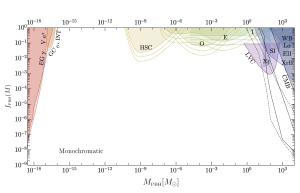Blog
The Hole Shebang
10 November 2023
 Caltech/R. Hurt (IPAC)
Caltech/R. Hurt (IPAC)There are three known types of black holes in the Universe: supermassive black holes that lurk in the centers of galaxies, stellar-mass black holes that are the remnants of massive stars, and intermediate-mass black holes that can be found in dense clusters of stars. But there is a fourth, hypothetical type of black hole known as primordial black holes (PBHs). If they exist, they could solve a few cosmological mysteries.1
There are lots of primordial black hole models, but they all propose that they formed in the earliest moments of the universe. Depending on the particular model, they could range in size from tiny, mountain-mass ones to sub-stellar black holes more massive than a super-Earth. If they are particularly massive, they could have been the seeds of the galactic black holes we see today. If they are particularly tiny, they might be the source of dark matter.
There are also a few more subtle mysteries that PBHs might solve. One of them is known as the near-infrared background excess.2 Just as there is a background of microwave radiation from the Big Bang, there is also a cosmic background of light in the near-infrared. Most of this is accounted for by the range of known astrophysical processes that generate heat, but the observed amount is a bit more than we can explain. We don’t know the cause of the excess, but it could be caused by heat generated by primordial black holes as they consume small amounts of interstellar gas.
Then there is the fact that since PBH models depend critically on the conditions of the early Universe, if we discover primordial black holes of a certain number within a certain mass range, it will allow us to distinguish between early Universe models, giving us a better understanding of the Big Bang.
 Bagui, et al
Bagui, et alUnfortunately, all searches for these hypothetical creatures have come up empty. We have looked for microlensing events where a black hole passes in front of a distant star, lensing its light and causing it to appear brighter for a time. We’ve looked for the bursts of light as Hawking radiation causes them to emit a flash as they radiate away. We’ve tried to observe their gravitational waves as they merge to become larger black holes. All of these observations have placed limits on what their masses could be and how common they might be in the cosmos, but they remain unobserved, assuming they exist.
The good news is that future observations have a good chance of finding them if they are real. In particular, gravitational wave observatories such as the space-based LISA telescope could have the sensitivity to observe both large-mass primordial black holes and high-energy smaller-mass ones. Either LISA and other observatories will prove they are real, or the mass and distribution limits of PBHs will be so tightly constrained that they can’t be used to explain most cosmological mysteries.
All we can do for now is to keep looking.